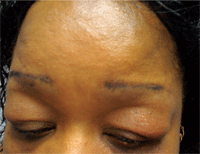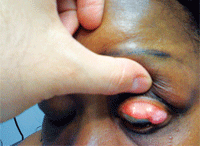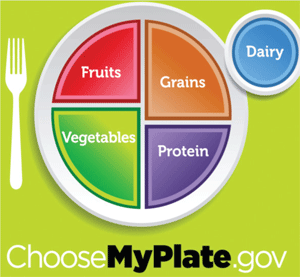Obesity is characterized by excessive fat accumulation in adipose tissue and other organs. It is an established risk factor for many systemic conditions, including coronary artery disease, type 2 diabetes mellitus, hypertension, stroke, dyslipidemia, osteoarthritis and sleep apnea.1 It has also been associated with certain types of cancers, such as endometrial, renal, colonic and breast cancers.2

Another co-morbidity of obesity is depression, secondary to poor self-image or social stigmatization and discrimination.3,4
While the impact of excess weight on systemic and mental health is well documented, the potential ocular effects of obesity receive little attention in medical literature. However, a number of ophthalmic disorders have been associated with excess weight and obesity (
see “Ocular Conditions Associated With Obesity.”).5,6
Case Report
A 43-year-old black female presented for a follow-up visit to monitor her bilateral primary open-angle glaucoma. She complained of a gradual onset of bilateral ocular irritation, burning and tearing. The patient also noted a ropy, mucoid discharge that was usually worse in the morning. She had been using the same topical prostaglandin analog for several years, without any notable side effects.


1. Floppy eyelid syndrome in an obese female with glaucoma, diabetes and obstructive sleep apnea.
2. Blepharitis and meibomian disease were ruled out, but upper lid laxity and bilateral ptosis were noted.
Our patient underwent a complete physical exam four months prior, and the examining physician pronounced her in good overall health. Her body mass index (BMI) was 35.2 kg/m2, which is considered Grade 2 obesity. Because body mass index is calculated using a formula that factors in both height and weight, it serves as a more reliable screening tool than weight alone to identify whether or not a patient is obese.
Concerned about this excess weight, the patient’s physician encouraged her to begin a program of walking and a diet that reduced her lipid and carbohydrate intake, emphasizing fruits, vegetables, whole grains and lean protein.
The patient noted that, at times, one of her superior eyelids would spontaneously flip (figure 1). She reported that she usually sleeps on her side or face down in her pillow. The patient indicated that she had poor quality of sleep, snored loudly and frequently woke up during the night. Despite sleeping for nine to 10 hours, she suffered from excessive daytime drowsiness.
While her visual function was unaffected and her glaucoma well controlled, biomicroscopy revealed bilateral punctate fluorescein staining of the superior cornea and conjunctiva. Both blepharitis and meibomian disease were ruled out. We noted a slight bilateral ptosis and unusually lax upper eyelids (figure 2).
Both upper eyelids were easily everted when pulled superiorly toward the eyebrow. As she presented in mid-morning, a mild mucoid discharge was still present in the lower left conjunctiva.
Diagnosis
Based upon these findings, we diagnosed floppy eyelid syndrome. We initiated conservative treatment with a viscous, preservative-free artificial tear prescribed every three hours, and a lubricating ophthalmic ointment to be used before bedtime. We instructed her to use an eye shield while asleep to protect the lids and conjunctivae from rubbing on the pillow. We also referred her to a pulmonologist who specializes in sleep medicine. The pulmonology consult resulted in a formal diagnosis of obstructive sleep apnea (OSA). She began using a continuous positive airway pressure (CPAP) device to keep her airway open during sleep.
O
cular Conditions Associated
With Obesity
• Hypertensive retinopathy
• Retinal vascular occlusions
• Diabetic retinopathy
• Metastatic disease
• Floppy eyelid syndrome
• Pseudotumor cerebri (papilledema)
• Cataract
• Glaucoma
• Age-related maculopathy
• Thyroid eye disease
• Non-arteritic anterior ischemic optic
neuropathy (NAION)
The patient was referred to a certified diabetes educator with a background in nutrition. Six weeks later, the patient reported “much less” ocular irritation than at her prior visit. She was pleased that she had also lost four pounds. Some scattered superior punctate corneal staining remained, but there was no mucoid discharge. The patient continued with her program of improved nutrition and increased physical activity.
Prevention and Dietary Management
Obesity management may include dietary modification, exercise programs, behavioral changes (including sufficient sleep), medications and bariatric surgical care.7 As primary health care providers, part of our job description is to educate our patients about the importance of nutrition and physical activity to both ocular and general wellness. Of course, prevention is the ideal way to combat this epidemic.
Nutrition-based measures are essential to managing weight loss. The Center for Nutrition Policy and Promotion, an organization of the U.S. Department of Agriculture, was established in 1994 to improve the nutrition and well being of Americans. In working toward this goal, the center has created a USDA Food Guidance System. Recently, the familiar USDA Food Guide Pyramid has been replaced by the new MyPlate icon, which emphasizes the fruit, vegetable, grains, protein and dairy food groups ( see “More About MyPlate.”).8
The prevalence of obesity has reached epidemic proportions in many countries, particularly in the U.S. Although its impact on overall health is well documented, less is known about the ocular manifestations of obesity. Among different eye diseases, obesity has been linked with floppy eyelid syndrome, papilledema, age-related maculopathy and diabetic retinopathy.
Optometrists should be familiar with the possible associations of eye disease with excess weight, and the potential for healthy weight loss as part of the therapeutic regimen.
1. Rexford SA. Digging deeper into obesity. J Clin Invest. 2011 Jun 1;121(6):2076-9.
2. Flegal KM, Graubard BI, Williamson DF, Gail MH. Cause-specific excess deaths associated with underweight, overweight, and obesity. JAMA. 2007 Nov 7;298(17):2028-37.
3. Faith MS, Matz PE, Jorge MA. Obesity-depression associations in the population. J Psychosom Res. 2002 Oct;53(4):935-42.
4. Sjoberg RL, Nilsson KW, Leppert J. Obesity, shame, and depression in school-aged children: a population-based study. Pediatrics. 2005 Sep;116(3):e389-92.
5. Cheung N, Wong TY. Obesity and eye diseases. Surv Ophthalmol. 2007;52(2):180-95.
6. Klein BE, Klein R, Lee KE, Jensen SC. Measures of obesity and age-related eye diseases. Ophthalmic Epidemiol. 2001 Sep;8(4):251-62.
7. World Health Organization. Obesity: preventing and managing the global epidemic. Geneva, Switzerland: World Health Organization; 2000.
8. USDA Publication number: Home and Garden Bulletin No. 232-CP. HHS Publication number: HHS-ODPHP-2010-01-DGA-B. June 2011.
ChooseMyPlate.gov also includes
practical information and tips to help Americans make healthy lifestyle
and dietary changes, such as:
Balancing Calories
Foods to Increase
Foods to Reduce
Source:
ChooseMyPlate.gov
More About MyPlate

• Enjoy your food, but eat less.
• Avoid oversized portions.
• Make half your plate fruits and vegetables.
• Switch to low-fat or fat-free milk.
• Make at least half your grains whole grains.
• Compare sodium (salt) in foods like soup, bread and frozen meals, and choose foods with lower numbers.
• Drink water instead of sugary drinks.

